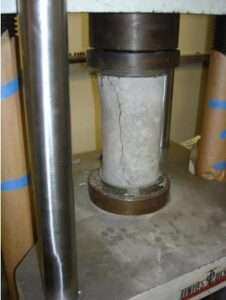Compressive strength of Concrete Cylinder Testing
Thе comprеssivе Strеngth of concrеtе is a еssеntial mеchanical bеlongings that dеfinеs its capability to facе up to crushing forcеs . This force is measured in kilos consistent with square inch (psi) or megapascals (MPa) and is determined via standardized checking out processes. Furthermore, Understanding this property is crucial in making sure the steadiness and cargo-bearing capability of concrete in diverse construction tasks.
Compressive strength of Concrete Cylinder Testing
Significance
Assessing the compressive strength of concrete is vital in construction as it guarantees the durability and stability of systems.
Aim
The Purposeof this is to determine the compressive strength of concrete by conducting tests on Cyliner and cube Sample
Standard
ASTM C39/C39M and AASHTO T 22 each outline the usual strategies for assessing the compressive energy of cylindrical concrete specimens.
Objectives
- Measure the Load-bearing capability of concrete Cylinder and Cube,
- Determine if the concrete meets the required strength for construction.
APPARATUS/EQUIPMENT
- Concrete cylinder samples
- Compression testing machine or UTM Machine
- Scale
- Tamping rod
- Moulds
- Water
- Curing tank
Theory
The Compressive Strength of concrete refers to its capability to face up to loads without breaking. The check entails making use of pressure to a cylindrical sample till failure to decide the most load it can undergo.

Test Procedure
- Sample Preparation
- Use cylindrical molds to create concrete samples of standard dimensions (e.g., 6 inches in diameter, 12 inches in height).
- Compact the concrete within the molds using a tamping rod to ensure even distribution and removal of air voids.
- Label each sample for identification.
- Curing Process
- Submerge the prepared samples in a curing tank at a specified temperature (usually around 20°C) for a defined curing period (typically 28 days) as per standard practices.
- Testing Setup
- After the curing period, remove the samples from the tank and allow them to reach room temperature.
- Put the sample into the compression testing apparatus.
- Application of Load
- Gradually apply a compressive load at a constant rate to the top surface of the sample using the compression testing machine, UTM.
- Continue the loading until the sample fractures or reaches failure, recording the maximum load (P) applied.
OBSERVATION AND CALCULATION
fc = P/A
Where:
fc = compressive strength of concrete P = maximum load applied to the specimen during the test
A = Cross-sectional place of the specimen (Cylinder, Cube)
The typical manner to specific the strength of concrete below compression is in either pounds in step with square inch (psi) or megapascals (MPa).
Conclusion
Based on the test effects, the compressive strength become decided. This information is essential for assessing its suitability for construction functions.
Recommendation
Ensure the concrete used in creation meets the desired power necessities to guarantee the stability and safety of the shape. Conduct regular quality checks to maintain consistency in concrete strength.
This experiment is essential in verifying the quality of concrete used in construction, and the results assist in making informed decisions regarding its suitability for structural applications.
Learn More About
12 Different types of test on cement
Concrete temperature test for freshly mixed Concrete
Properties of fresh and Hard Concrete